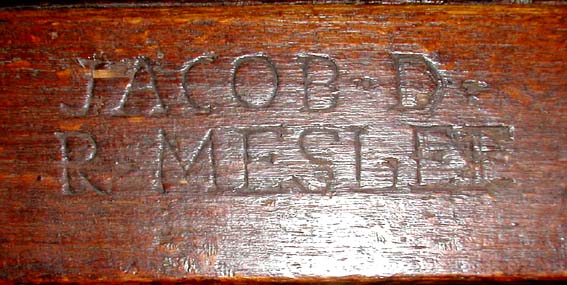|
|
JACOB

The dynasty of JACOB Carpenter
One of the most famous family of cabinetmakers who managed to stay ahead during more than 80 years. The three generations that followed were those of Georges Jacob, his two son, George II and François-Honoré-Georges, and his great son Georges-Alphonse.
Georges Jacob (1739-1814)
He arrived in Paris at sixteen years old. He worked with Delanois with whom he remained very close. He graduated September 4, 1765 and settled without taking the succession of another master. In 1767 he married Jeanne-Germaine Loyer, rue de Clery and settled in 1775 rue Meslée. They had five children, amoung two became carpenter.
In 1773, he started to work for the Garde Meuble de la Couronne, this collaboration will be interrupted by the Revolution. Amoung Its clientele was Queen Marie Antoinette, the king and royal family, especially the Comte de Provence (the future Louis XVIII), the Comte d'Artois (the future Charles X), the Prince de Conde, the Duc de Penthievre and foreign courts.
Some of his work is considered as masterpieces of carpentry
His talent is fully expressed in his Louis XVI style creations and he has been credited with many developments:
-The Jacob-feet, this term should include foot console.
-The use of mahogany woodwork.
-The quiver feet found on many orders for Queen Marie Antoinette.
-Curule inspired seats of Roman antiquity.
George Jacob spent the revolutionary period without being molested due to his friendship with the painter David. In 1796 his two son, George son François-Honoré took over.
They create the company Jacob frère rue Meslée and manufacture furniture and seats in the Consulate and Directoire stye.
The fame of their father gave them a large clientele including:
-General Bonaparte.
-Josephine pour le chateau de la Malmaison.
-The Tuileries Palace.
-The famous "Madame Recamier"
Their production is characterized by:
-the almost exclusive use of mahogany.
-inlaid ebony, lemon and tin.
-arch folders to which the curve is very pronounced.
-Post-feet swords.
-Great quality animals and busts of Egyptian sculptures
On the death of George in 1813, François-Honoré associated with his father George Jacob and changed the name of the company to Jacob Desmalter.
Jacob George II (1768-1803)
He worked only on the administrative side of this vast enterprise. He was associated with his brother from 1796 to his death under the name "Jacob Brothers." He died October 23, 1803.
François-Honoré-Georges Jacob-Jacob said Desmalter (1770-1841)
He married April 21, 1798 Miss Lignereux Adelaide Anne. Their situation was prosperous. They had five children, the elder Alfonse George became a pupil and successor of his father. He added Desmalter to its name.
In 1796, Georges Jacob gave him his business. He teamed with his brother George II, until the death of the latter, under the name "Jacob's Brothers".
He gave a new extension to the florishing business.
in 1808 the company has 332 workers to fill all orders. Among its sponsors must include:
-The Imperial Guard Cabinet.
-L'Impératrice Josephine at Chateau de la Malmaison.
-The Bonaparte family.
-the dignitaries of the Empire.
-La Duchesse de Berry
Advised by the painter David and decorators by Percier and Fontaine, he is inspired by ancient Greco-Roman and created numerous designs for furniture and style seats and restaurant empire.
However, the continental blockade imposed by Napoleon in 1806 led to the stagnation of business and the bankruptcy of Jacob's house.
To pay its creditors, George Jacob divorced and gave the company to his wife.
In 1819 a fire destroyed his workshops.
In 1822 he took a partner, François Bouvattier, a wwod merchant, under the name "Jacob & Co. Desmalter"
Georges-Alphonse Jacob-Desmalter (1799-1870)
He began decorating with his father, then became a student of Percier before returning to his father's shop and take over the lead on 1st January 1825.
in May 1824, he created a partnership with Emile Hermart, under the name "A. Jacob and Sons Co.: manufacture and trade of furniture and bronzes, as well as carpentry work.
He manufactured and provided many pieces of furniture for royal castles. He was considered as one of the oldest manufacturers of Paris.
George Alphonse put an end to his activity as a cabinetmaker in 1847 and will focus on architecture.
He awaited the death of his mother to sell the family business to Jeanselme in 1847.
|